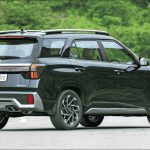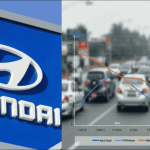
Hyundai Motor India has reclaimed the third position in India’s domestic passenger vehicle market in May 2025, ending a three-month streak where it had been relegated to fourth place behind Mahindra and Tata Motors. This strategic recovery marks a significant milestone in the intensely competitive Indian automotive landscape, where market positioning shifts can dramatically impact brand perception and dealer confidence.
Overview: May 2025 Indian Passenger Vehicle Sales Rankings
| Rank | Manufacturer | May 2025 Sales | May 2024 Sales | YoY Change | Market Share |
|---|---|---|---|---|---|
| 1st | Maruti Suzuki | 1,35,962 units | 1,44,002 units | -5.6% | 38.9% |
| 2nd | Mahindra & Mahindra | 52,431 units | 43,218 units | +21.0% | 15.0% |
| 3rd | Hyundai Motor India | 43,861 units | 49,191 units | -10.8% | 12.5% |
| 4th | Tata Motors | 41,557 units | 46,697 units | -11.0% | 11.9% |
| 5th | Toyota Kirloskar | 29,280 units | 25,273 units | +15.9% | 8.4% |
| 6th | Kia India | 22,375 units | 19,545 units | +14.5% | 6.4% |
| Gap | Hyundai vs Tata | +2,304 units | -2,494 units | Hyundai ahead | +0.6% share |
The Narrow Victory: A Battle of Numbers
Hyundai’s return to the third position wasn’t achieved through spectacular growth but rather through strategic market management during challenging times. The Korean automaker’s domestic wholesales of 43,861 units in May 2025 narrowly edged past Tata’s 41,557 units by a margin of just 2,304 units. This razor-thin difference underscores the fierce competition in India’s passenger vehicle segment, where even small operational decisions can determine market standings.
Despite recording a 10.8% year-over-year decline compared to May 2024’s performance, Hyundai managed to outperform Tata Motors, which experienced an even steeper 11% decline during the same period. The victory was also aided by month-on-month performance, where Hyundai’s sales dropped only 1.2% from April 2025’s 44,374 units, while Tata’s sales declined by a more significant 8.1%.
Market Dynamics: Understanding the Shift
The May 2025 sales data reveals several critical market dynamics that influenced the reshuffling of positions among India’s top automakers. Overall passenger vehicle wholesales in May 2025 remained tepid, with total industry volumes reaching 3,49,713 units, representing marginal 0.2% growth compared to May 2024 but declining 1.1% from April 2025’s stronger performance.
Mahindra’s Continued Dominance: The most significant story remains Mahindra & Mahindra’s consolidation of the second position with robust 21% year-over-year growth. The SUV specialist’s passenger vehicle division recorded 52,431 units, establishing a comfortable lead over both Hyundai and Tata. Mahindra’s success stems from its focused SUV portfolio, featuring popular models like the Scorpio-N, XUV700, Thar, and Bolero Neo, which align perfectly with current consumer preferences.
Maruti’s Challenging Leadership: While Maruti Suzuki retained its market leadership position, the company faced a 5.6% year-over-year decline, with market share dropping to 38.9% from 41.3% in May 2024. The decline was primarily attributed to weakening demand for entry-level cars and the ongoing India-Pakistan conflict, which reportedly impacted sales in northern regions.
Factors Behind Hyundai’s Recovery
Several factors contributed to Hyundai’s ability to edge past Tata Motors in May 2025:
Production Strategy Management: Hyundai cited a regular week-long biannual maintenance shutdown at its Chennai facility as a factor affecting the availability of some in-demand models. However, the company’s production planning ensured that this planned downtime didn’t severely impact overall monthly performance, demonstrating effective inventory and supply chain management.
Export Performance Strength: While domestic sales declined, Hyundai’s export performance remained robust, with 14,840 units shipped internationally. This export strength positioned Hyundai as the second-largest player in terms of overall dispatches (58,701 total units), even ahead of Mahindra’s total of 54,819 units. The strong export performance indicates healthy international demand for models like the Grand i10, Aura, and Verna.
Model Portfolio Resilience: Despite overall volume decline, Hyundai’s compact SUV and premium hatchback segments continued to show resilience. The Creta remained a segment leader with 14,860 units sold, contributing significantly to the company’s market recovery efforts.
Tata Motors’ Challenges
Tata Motors’ slip to fourth position reflects several operational and market challenges:
Broad-Based Decline: Unlike Hyundai’s focused production issues, Tata experienced broader market pressures with 11% year-over-year domestic sales decline. The company’s wholesales dropped from 46,697 units in May 2024 to 41,557 units in May 2025, indicating systematic market share erosion.
Mixed EV Performance: While Tata’s electric vehicle sales showed marginal 2% improvement to 5,685 units, this growth was insufficient to offset broader passenger vehicle decline. The EV segment, once Tata’s strength with models like the Nexon EV, faced increased competition from new market entrants.
Model-Specific Pressures: The Tata Punch, previously a volume driver, experienced a 31% year-over-year decline, selling 13,133 units compared to 19,052 units in May 2024. This significant drop in one of Tata’s popular models contributed to the overall sales decline.
Industry Context and Broader Implications
The May 2025 results reflect broader industry trends and challenges:
SUV Segment Dominance: The continued success of SUV-focused manufacturers like Mahindra highlights the ongoing consumer preference shift toward utility vehicles. SUVs accounted for over 55% of passenger vehicle sales, validating strategies of companies with strong SUV portfolios.
Entry-Level Segment Challenges: The decline in entry-level car sales, particularly affecting Maruti’s mini and compact segments, suggests changing consumer behavior. Buyers are increasingly opting for feature-rich, higher-priced vehicles, impacting traditional volume drivers.
Export Market Importance: Strong export performance emerged as a crucial differentiator, with companies like Hyundai leveraging international demand to maintain overall volume growth despite domestic challenges.
Strategic Outlook and Future Prospects
Hyundai’s recovery to third position, while narrow, provides crucial momentum for the company’s ambitious product roadmap. The Korean automaker has announced plans for 26 new model launches by 2030, including the Bayon crossover, next-generation Venue, and India’s first Hyundai hybrid vehicles.
For Tata Motors, the fourth-position setback comes at a time when the company is launching new products like the Altroz facelift and Harrier EV. The success of these new launches will be critical in determining whether Tata can quickly reclaim its third-position standing.
The narrow gap between Hyundai and Tata (just 2,304 units) suggests that the battle for third position will likely continue fluctuating in coming months, making the remainder of 2025 a crucial period for both manufacturers’ strategic positioning.
Market Leadership Implications
While Hyundai’s third-position recovery represents a tactical victory, the broader strategic challenge remains significant. The company’s 10.8% year-over-year decline indicates underlying market pressures that require structural solutions rather than temporary operational adjustments.
The May 2025 results demonstrate that in India’s hyper-competitive passenger vehicle market, consistency in product launches, pricing strategies, and market adaptation ultimately determines sustained success. As manufacturers navigate evolving consumer preferences, supply chain challenges, and competitive pressures, the ability to maintain market position while investing in future technologies will separate market leaders from followers.
Frequently Asked Questions (FAQs)
Q1: By how many units did Hyundai overtake Tata in May 2025? A: Hyundai overtook Tata by 2,304 units, with Hyundai selling 43,861 units compared to Tata’s 41,557 units in domestic sales.
Q2: Which company holds the second position in India’s passenger vehicle market? A: Mahindra & Mahindra secured the second position with 52,431 units sold, registering a strong 21% year-over-year growth.
Q3: Did Hyundai’s sales increase or decrease in May 2025? A: Hyundai’s domestic sales decreased by 10.8% year-over-year but the company still managed to overtake Tata Motors for third position.
Q4: What factors helped Hyundai reclaim the third position? A: Strong export performance (14,840 units), better month-on-month decline management, and resilient performance in compact SUV segments helped Hyundai overtake Tata.
Q5: How did the overall passenger vehicle market perform in May 2025? A: The overall market showed tepid growth with 3,49,713 units sold, representing just 0.2% year-over-year growth and a 1.1% decline from April 2025.













